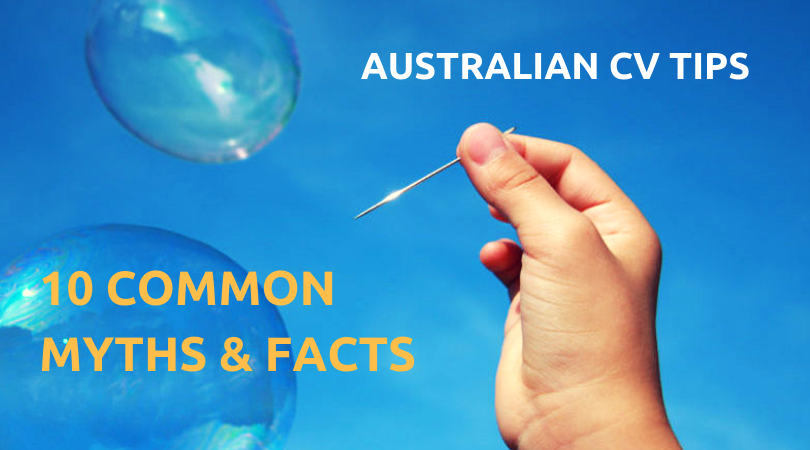Australian resume or CV often strikes fear amongst new Australian job seekers. With so much information available on the internet, it’s difficult to identify what is and isn’t current and relevant to Australian jobseekers.
In this blog post, we’ve dispelled some of the myths and confusion about the Australian resume to guide first-time Australian job seekers to the right path.
Myth #1: Australian resumes should be no more that one page
Truth: Australian resumes can exceed a single page. This is true even for University students or school leavers who have relevant internships, work experience, academic projects or extracurricular activities.
For professionals, a two or three-page resume is recommended to allow for sufficient space to include all relevant work history. Senior executives or those in the medical, legal, academic or engineering fields can write a resume in between three to four pages to include their placement, projects, licences, presentation, publications, memberships and other relevant details.
Myth #2: Australian resumes should be black and white
Truth: When it comes to resume format, Hiring Managers and/or recruiters appreciate creativity and the element of colour on a resume. A safe resume colour scheme is to use up to three colours (black, white and a third light colour such as light blue or grey) to place emphasis or break up different resume sections.
To create a personal branding, use the same colour scheme in all applications documents such as in cover letter and selection criteria.
Myth #3: Australian resumes should have a separate section for ‘Career Highlights’ or ‘Achievements’
Truth: A separate ‘career highlights’ or ‘achievements’ section is often overlooked by Hiring Managers and/or recruiters. To avoid this, it’s advisable to put accomplishments in bullet points under each role or position.
Job seekers in non-quantifiable fields can still include achievement bullet points by focusing on soft skills such as the number of employees trained, the volume of inbound calls received or the frequency of performing a specific function within a particular time period.
Myth #4: Australian resumes should have a ‘Career Objective’ section
Truth: Modern Australian resumes no longer have a ‘Career Objective’ section. Job seekers should not talk about what they wanted for themselves but should focus on what they could offer to a potential employer.
The objective statement should then be replaced with a ‘Professional Profile,’ a personal statement or introductory paragraph that highlights a job seekers’ years of relevant experience (or relevant degree, for University students/graduates), next career move and signature skills.
Myth #5: Australian resumes should list all the job seekers’ work experience
Truth: For those with more than 10 years of experience, a resume is not the best place to include every single bit of experience you’ve ever had.
The standard rule of thumb is to include your work experience in the last decade (10 years). However, if some older roles are still relevant to the positions you’re seeking, briefly mention these roles. Your resume’s main focus should be your two most recent positions.
Myth #6: Australian resumes should be generic and flexible enough to increase one’s chances of getting a job
Truth: Remember that the more general you are in your approach to job search, the less you stand out.
Targeted resumes are the only ones that are successful in securing interviews. Rather than drafting a generic resume, job seekers should take extra effort to conduct extensive research to understand the required competencies, skills, experience or qualifications for the intended role.
Customised resumes are particularly important for career changers who wanted to make a strong first impression in a pool of more qualified job seekers.
Myth #7: Australian resumes are enough for job hunting
Truth: LinkedIn profiles have quickly become supplementary to resumes, aiding job seekers in finding employment, thanks to its networking facilities.
Sometimes, your resume alone cannot do all the heavy lifting. So it’s equally important to enhance various sections of your LinkedIn profile to improve your chances of being found online by recruiters or headhunters.
Myth #8: It’s OK to have white lies on Australian resumes
Truth: Lying on a resume, in general, whether a little white lie or an intentional fabrication, could equate to potential career sabotage since today’s technological advancement make it a lot easier to get caught. Many companies also use outside firms to perform verifications with prior employers and schools.
You should avoid lying about your education and degrees, employment gaps, job titles and accomplishments.
Myth #9: For security, Australian resumes should be sent as PDF
Truth: Send your resume in MS Word format unless a job ad specifies that you send it in PDF.
Why?
There is a 90% chance that your targeted employer uses an Applicant Tracking System (ATS) or resume scanner. This means that are digitally importing your resume into a candidate database to compare against the job description. This parsing tool works best using MS Word.
Although resume scanners nowadays can read and process PDF’s, you are always safe with MS Word. MS Word is also universal. Nearly everyone has a copy of MS Office, and most companies have standardised on it.
Myth #10: The purpose of a well-written Australian resume is to get you a job
Truth: Not necessarily. A good resume only gets you an interview. Once you’re in front of the Hiring Manager, you’ll need to promote yourself even better than the resume that sold you to secure a job interview.
Hence, the resume is only one step in a series of the job search process.
Before the actual interview, try practising your response to some of the most common interview questions, such as ‘Why are you applying for this job?’ and ‘What’s your greatest weakness?’
If you still have concerns about crafting a winning Australian resume, have it written by an expert.
Click here for more job search tips and advice.
For more ideas on how to craft winning resume, visit www.rev-upyourresume.com.au or connect with us through LinkedIn, Twitter, and Facebook.

